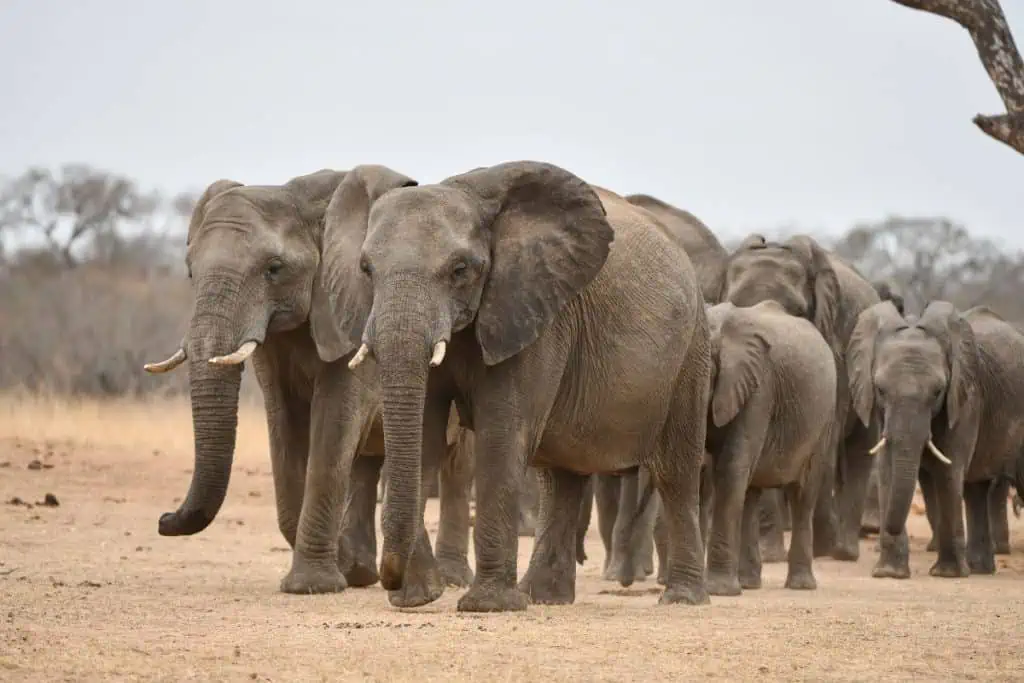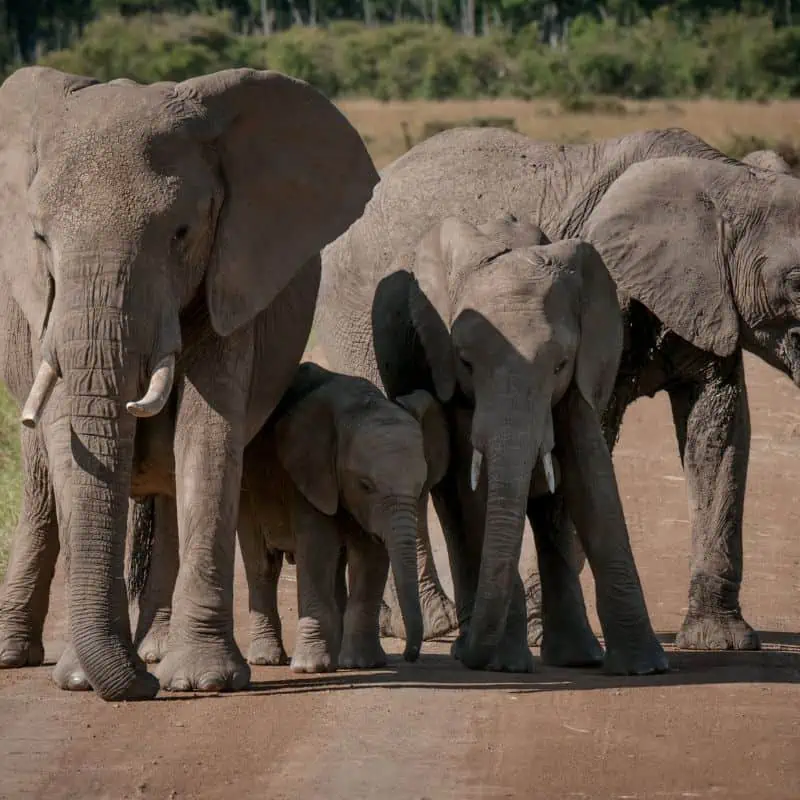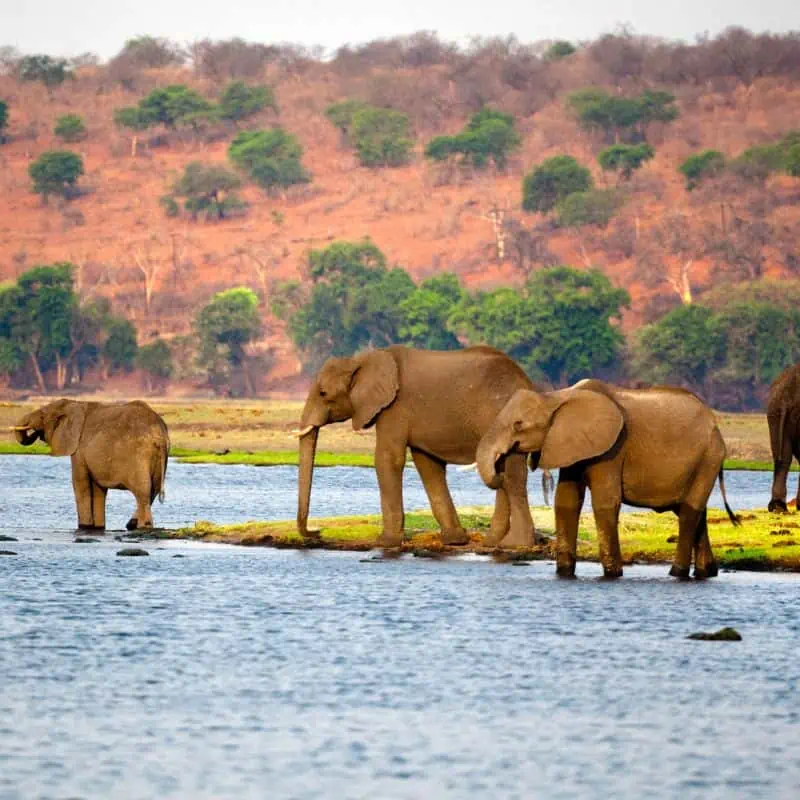Elephants are known as ecosystem engineers. An elephant footprint alone can start a micro-ecosystem. It would gravely impact the environment if elephants were to go extinct, so it is concerning to know how drastically their population has decreased worldwide over the years.
There are currently around 497,000 elephants left in the world. This is due to various reasons, such as human-elephant conflict, elephant poaching, and climate change that leads to habitat destruction.
In this article, we will explore the reasons behind the decreasing population of elephants and some of the measures implemented by authorities to conserve elephant populations.

The Total Population of Elephants
The elephant population has dwindled throughout the years in different continents. Both the African and Asian elephant population has decreased for many reasons.
1. African Elephant (415,000)
The population of African elephants is the biggest amongst the total population of elephants in the world.
According to the last official count of elephants in Africa in 2016, it is estimated that there are 415,000 elephants in the African region. However, this number has decreased from the previous year and is continuously decreasing.
South Africa has the largest population of elephants, estimated to be around 293,000, whereas West Africa has the smallest population, with only 11,500 elephants in the region.
Botswana hosts the largest population of elephants in one country, with an estimated 130,000 elephants.

African Bush Elephant (350,000)
The African bush elephants, also known as savanna elephants, are estimated to have around 350,000 individuals in the wild.
The savanna elephants are classified as endangered owing to the rapid decrease observed in their population.
Climate change, frequent habitat loss, and habitat destruction are common reasons for the population’s decrease. Illegal poaching for ivory and human-elephant conflicts have also played a significant role in their numbers falling.
African Forest Elephant (95,000 to 100,000)
All African elephants were considered one single species until 2021. Finally, scientists differentiated the smaller elephants in the continent’s dense tropical forests subspecies.
African forest elephants are critically endangered and at risk of being extinct.
After the official count of the African forest elephant in 2021, the population for the subspecies is roughly 100,000, with almost 95,000 forest elephants found in Gabon.
According to researchers, it is estimated that illegal poachers have slaughtered approximately 65% of the population of forest elephants in the last 12 years.
2. Asian Elephant (52,000)
The Asian elephant population has been decreasing rapidly for the past seventy years. There is an estimated 50% decline in the elephant population in Asia.
The elephant population in Asia is only a small percentage compared to Africa. Approximately 52,000 wild elephants are left in Asia, with India having the biggest Asian elephant population, having around 27,000 Asian elephants in the wild.
Countries such as Malaysia, Thailand, Sri Lanka, and Myanmar have an elephant population greater than 2000.
Other countries in the region, such as Cambodia, China, and Nepal, also have a small elephant population.
However, Pakistan’s elephant population has gone extinct in the last decade.
Loss of habitat and poaching of elephants for ivory remains the biggest threat to the elephant population in the region and still needs to be resolved.

What Threats Do Elephants Face?
A variety of factors and threats become a significant reason for the elephant population to decrease.
Here are some of the significant threats that elephants face:
1. Human-Elephant Conflict
Human-Elephant conflict is a significant threat that faces the elephant population.
One of the main causes of conflict between humans and elephants is the ongoing taking of their habitat and space.
Elephants trampling crops and raiding food storages lead to human retaliations and their killings.
Elephant-caused infrastructure destruction is another significant factor in the ongoing nature of this dispute.
2. Habitat Loss
Due to the expansion of human settlements, agricultural development, and infrastructures like roads, canals, and fences that split their habitat, elephants are also losing their habitats and historic migration routes.
Elephants require a lot of space to move around and grow. They have been unable to access critical migration routes and water supplies due to deforestation and artificial impediments.
African elephants have less space to roam than ever before. The elephants’ range shrunk from three million square miles in 1979 to slightly over one million square miles in 2007.
3. Illegal Poaching and Trade of Ivory
The estimated market for the illegal trade of ivory is said to be almost 10 billion dollars.
It is estimated that 33,000 African elephants were illegally poached in 2014 alone. The resulting consumer boycott and a ban on the sale of ivory resulted in reduced demand for tusks.
Currently, ivory is illegally traded throughout the world, with some African nations being the main culprits.
Some cases of ivory poaching involve sawing off tusks from wild elephants when they’re alive and leaving them bleeding to die eventually.
Tusks are often used as trophies or, in some cases, to make small trinkets, hairpins, and ornamental carvings.
Efforts for the Conservation of Elephant Populations
The World Wildlife Fund (WWF) has made great strides toward protecting and conserving the population of elephants.
It has made significant progress in resolving the conflict between humans and elephants. WWF works with many stakeholders to manage the conflict. They are implementing methods and technology such as fencing and other deterrents to prevent harmful encounters.
Banning the illegal trade of ivory has also been a significant step toward reducing elephant poaching. WWF has worked to lower domestic consumption of elephant ivory and make sure the Chinese ivory ban is strictly adhered to.
Other than WWF, some influential organizations are also working towards the conservation of elephants.
The following are some of the organizations working for the protection of elephants.
1. Save the Elephants
Save the Elephants is an organization based in Kenya established by Ian Douglas-Hamilton.
Ian felt this organization needed to foster hospitable relations between elephants and humans. The organization also works to fight against illegal elephant poaching.
2. Elephant Voices
Elephant voices is another incredible organization working towards protecting the elephant population by promoting ethical care of elephants through proper scientific research.
The organization’s study identified the distinctive ways that elephants interact with one another and the necessity to tailor elephant care to these behaviors.
3. Elephant Aid International
Elephant Aid International works towards providing education and hands-on assistance to end the suffering of wild elephants throughout the world.
The organization has been leading the world in teaching elephant carers, teaching them compassionate ways to take care of elephants, and doing their part in conserving the population of elephants.
Final Thoughts On The Global Population Of Elephants
The global elephant population has been decreasing for quite some time. We must realize the importance of elephants in our ecosystem and do everything in our power to conserve and protect elephants.
We hope this article was a much-needed insight regarding the elephant population and threats that elephants face.

FAQs
How Many Elephants Are Poached Daily?
It is estimated that close to 100 elephants are killed each day due to poaching or human-elephant conflicts.
Which Country Has the Highest Number of Elephants?
Botswana leads the world by having the largest elephant population, estimated to be around 130,000 to 150,000.
How Can You Protect the Elephant Population?
There are indirect ways to help conserve the elephant population. This can range from helping charitable organizations fight the noble cause of protecting the elephant population, being a responsible tourist, and boycotting any products made from raw materials produced by poaching.

